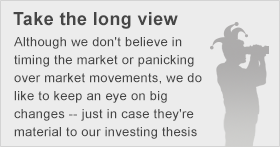
The S&P 500 and the narrower Dow Jones Industrial Average (^DJI 0.17%) were up 0.32% and 0.23%, respectively, at 10:15 a.m. EDT. This morning, the Consumer Price Index, or CPI, for March rose 0.2% month over month, compared to an 0.1% consensus estimate (the numbers are for the core CPI, which excludes food and energy costs.) That result looks pretty healthy; in fact, if you annualize the growth in March, you obtain an annual inflation rate of 2.4% -- only slightly above the Federal Reserve's 2% target. In any event, investors will be more focused on earnings (as they ought to be), with two Dow components, Coca-Cola (KO 0.06%) and Johnson & Johnson, having already reported their first-quarter results this morning and a third, Intel, reporting after the close.

Feel-good headlines are announcing that Coca-Cola beat Wall Street's expectations on revenue in the first quarter, but even a casual perusal of the data shows there is less to get excited about than these pronouncements suggest.
First, on that "beat": In the quarter ended March 31, Coca-Cola generated $10.58 billion in revenue, versus a consensus estimate of $10.53 billion. A $50 million difference, or 0.5%, lies within the margin of error, as far as I'm concerned; furthermore, it's dwarfed by the 4% year-on-year drop in revenue. (To be fair, excluding the impact of structural changes and currency effects, net revenue rose 2%; unit case volume grew 2% globally.)
Adjusted earnings per share of $0.44 were exactly in line with Wall Street's consensus estimate and down 4% year on year (up 5% on a currency neutral basis).
Coca-Cola has a growth problem, but this quarter provided some data that suggests that emerging markets could help pick up the slack for developed markets in which public health concerns and shifting consumer tastes are upending the playing field for sugary beverage makers. The same rebalancing process occurred with regard to tobacco companies.
Indeed, on a comparable currency neutral basis, net revenue rose 11% in Eurasia and Africa and 7% in Latin America (North America registered a 1% decline). The company grew volume 12% in China and 6% in India, the former being achieved with an increased marketing effort around the Chinese New Year.
Nonetheless, if I were a Coca-Cola investor, I'd be concerned that the company's competitive moat will erode in the near future. However, when that very question was put last month to one of its largest (and longest-tenured) shareholders, Berkshire Hathaway (NYSE: BRK-B) CEO Warren Buffett, this is how he responded:
[Coca-Cola] is under a lot more pressure than it was 10 or 15 years ago, particularly in the United States, but their sales went up last year -- just as they go up almost every year -- in terms of unit cases of carbonated soft drinks. They're right now 3% of all the liquids people put in their mouths throughout the whole 7 billion people are Coca-Cola products and think maybe that 3% will go up a little over time. I think they've got wonderful brands and wonderful acceptance around the world; Coca-Cola brand itself sold 100 million more cases last year, as I remember, than the year before and it sold more that year than the year before. It's a very, very good business.
Buffett knows more about Coca-Cola's business than I ever will, so I'd be inclined to give him the benefit of the doubt: Coca-Cola is a very, very good business -- albeit one that deserves greater ongoing scrutiny than it once did.








